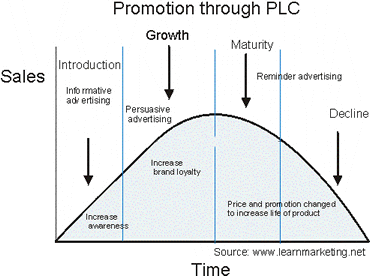The Marketing Mix
PROMOTION STRATEGIES
A successful product or service means nothing unless the benefit of such a service can be communicated clearly to the target market. An organisation's promotional mix strategy can consist of many things. The table below takes you through some of the methods.
Promotional Mix Methods
| Types of Promotion |
Explanation |
| Advertising |
Communication through mass media, the firm will usually pay for this type of communication. |
| Public Relations |
Developing a positive relationship between the organisation and the media and the public. Good public relationships involves not only creating favourable publicity through the media but also involves minimising the impact of negative situations. |
| Sales Promotion |
Promotions designed to create a short term increase in sales. Examples of sales promotion include money off coupons, discount codes and "flash sales". |
| Personal Selling |
Sales interaction between the firm's representative and a consumer on a one to one basis. |
| Direct Mail (post and e-mail) |
This involves sending marketing to a named individual or organisation. Firms often buy lists of names, e-mails and postal addresses for this purpose. This can be highly effective when the direct mail recipients are within the firm's target market. |
| Internet Marketing |
Placing adverts on internet pages through programmes such as Google's AdWords. |
| Social Media |
Firms place daily messages on social media such as Facebook and Twitter to keep customers interested in their organisation. They may even run promotions, flash sales and discounts just for their social media readers. |
| Sponsorship |
An organisation or event is paid to use your branding and logos. Sponsorship is commonly used in sporting events; player's clothing and stadiums will be covered in the firm's branding and even the tournament may be named after the firm. Although effective sponsorship requires a large audience you may get smaller firms interested in local business sponsoring small events in their area e.g. school fairs. |
Message Strategy - What Message Will The Promotion Conveying?
Firms need to carefully consider the message that their promotion strategy will be conveying to their target audience. What message will promotion activity send to the target audience and how will it impact on the firm's reputation?
The promotion's message should reinforce product benefits and help the firm to develop a positioning strategy for their products. Apples message strategy reinforces the quality that they are trying to create about their brand. Mcdonalds message strategy is about the convenience of their products and the value they offer.
Media Strategy And How Will Promotion Help Deliver The Message
Media strategy refers to how the organisation is going to deliver its message. What aspects of the promotional mix will the company use to implement their media strategy. Where will they promote it? Clearly the company must take into account the readership and general behaviour of their target audience before they select their media strategy. What newspapers do their target market read? What TV programmes do they watch? Targeting through effective media campaigns could save the company valuable financial resources. Amazon is a good example of an organisation that uses a varied promotional mix, which includes, TV, online and print. Amazons media strategy reflects the diversity of their customers.
Promotion Through The Product Life Cycle
As products move through the four stages of the product life cycle different promotional strategies should be employed at these stages to ensure the healthy success and life of the product.

Promotion strategies that can be employed at each stage of the Product Life Cycle are as follows:
- Introduction
When a product is new the organisation's objective will be to inform the target audience of its entry. Television, radio, magazine, coupons etc may be used to push the product through the introduction stage of the life cycle. Push and Pull Strategies will be used at this crucial stage.
- Growth
As the product becomes accepted by the target market (at this stage of the life cycle) the organisation will employ strategy to increase brand awareness and customer loyalty.
- Maturity
At this stage of the life cycle the product will be experiencing increased competition and will need persuasive tactics to encourage consumers to choose their product over their rivals. Any differential advantage/benefit will be need to be clearly communicated to the target audience.
- Decline
As the product reaches the decline stage of its life cycle, all the organisation can do is use strategy to remind consumers about the product in a bid to slow the inevitable.
Promotion Through The Internet
The development of the world wide web has changed the business environment forever. Dot com fever has taken the industry and stock markets by storm. The e-commerce revolution promises to deliver a more efficient way of conducting business. Shoppers can now purchase from the comfort of their home 24 hours a day 7 days a week.
Owning a website is a now a crucial ingredient to the marketing mix strategy of an organisation. Consumers can obtain instant information on products or services to aid them in their crucial purchase decision. Sony Japan took pre-orders of their popular Play Station 2 console over the net, which topped 1 million after a few days, European football stars issue press releases through the internet and have websites registered under their names. Hit rates are phenomenal. Advertisers have now moved their money over to the internet as customers are now spending more time online than watching TV.
If you would like to learn more about the promotion mix and promotional strategy take a look at our promotional mix expanded article which includes above the line advertising, below the line advertising and through the line advertising.
Related Links Marketing Mix Price | Marketing Mix Product | Marketing Mix Place | Marketing Mix 4Cs




